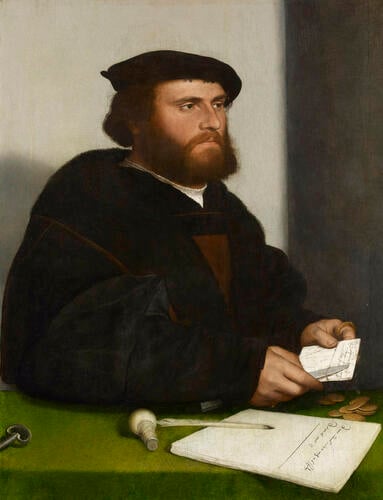A Merchant of the German Steelyard: 'Hans of Antwerp' after Sep 1532
Oil on panel augmented with canvas | 63.0 x 48.4 cm (support, canvas/panel/stretcher external) | RCIN 404443
-
Holbein's portrait depicts the sitter, who is possibly a merchant, in an expensive but understated fur-lined gown and doublet. He is at work, surrounded by coins, a key and his seal, and is in the act of cutting the string of a letter he has just received – but he has momentarily paused. His quill pen rests on a letter he has just begun.
Recent cleaning, the result of an extensive two-year project, has removed a thick layer of discoloured varnish from this painting, allowing more of Holbein's original work to be seen: this includes several rings on the sitter's left hand, and the artist's last touches and details, notably the eyelashes and the single strands of hair.
Hans Holbein the Younger was born in Augsburg where he was trained by his father, Hans Holbein the Elder (c.1460-1524). He became a member of the painter's guild at Basel in 1519 and visited France in 1524 and London in 1526-8. After returning to England in 1532, he was employed by Henry VIII, and painted numerous portraits of the King and court, remaining in royal service until his death (probably by plague) in 1543.
Upon first returning to England from Basel in the summer of 1532, Holbein found that most of his former English patrons were dead or had fallen from political favour. He therefore found work as a portraitist for the German merchants of the Hansa Steelyard, in Thames Street, the London establishment of the Hanseatic League, and this portrait is currently believed to be one of only seven remaining portraits he produced between 1532 and 1533 of the League's German members.
However, the identification of the sitter has long been a subject for debate; the painting was recorded in the Royal Collection in the reign of Charles I as 'the Picture of a Merchant', and his identity simply as a man, or a German merchant, persisted until the mid-nineteenth century. The inscription on the paper before him – in so-called 'merchant script' – seems to provide more information, and in 1874 it was read as 'Dem ersamen H[a]nnsen / Von anwerpen'.
The sitter was therefore connected with the goldsmith 'Hans of Antwerp', who was between 1537-47 in the employ of the crown. He and Holbein appear to have been friends: Hans witnessed Holbein's will, and Holbein designed for him an elaborate cup, inscribed HANS VON ANT. However, there is no record of Hans of Antwerp as a Hanseatic merchant, and the inscription is not clear enough to confirm the attribution. More recently, conservators working at the Royal Collection have been able to reveal that the bottom of the sitter's seal, which formerly appeared as a 'W', was in fact a mark made of a circle and crossed lines – the same mark visible on the letter the man holds, and recognisable as belonging to a merchant. In the light of this new evidence, it is believed that the sitter is not Hans of Antwerp, but perhaps a Hanseatic merchant who shared his name: he could have been a German merchant based at the London Steelyard with strong trading links with the city of Antwerp.Provenance
Presented to Charles I by Sir Henry Vane, who apparently 'brought it out of Germany; recorded in the King's Chair Room at Whitehall in 1639 (no 35); sold for £45 to Captain Geere on 14 May 1650 from St James's Palace (no 45); recovered at the Restoration and listed in the King's Closet at Whitehall in 1666 (no 309)
-
Creator(s)
Acquirer(s)
-
Medium and techniques
Oil on panel augmented with canvas
Measurements
63.0 x 48.4 cm (support, canvas/panel/stretcher external)
61.0 x 46.8 cm (support (etc), excluding additions)
83.0 x 68.0 x 6.7 cm (frame, external)
Category
Object type(s)
Other number(s)
Alternative title(s)
An anonymous merchant of the German steelyard, traditionally identified as Hans of Antwerp
An anonymous merchant of the German steelyard, traditionally identified as John of Antwerp
An anonymous merchant of the German steelyard, traditionally identified as John van der Gow
An anonymous merchant of the German steelyard, previously identified as Holstoff












